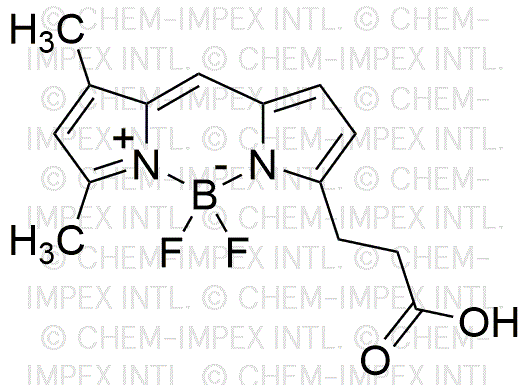4,4-Difluoro-5,7-dimethyl-4-bora-3a,4a-diaza-s-indacene-3-propionic acid is widely utilized in research focused on:
- Fluorescent Probes: This compound serves as a highly effective fluorescent probe in biological imaging, allowing researchers to visualize cellular processes with high sensitivity and specificity.
- Drug Development: Its unique properties make it valuable in the pharmaceutical industry for developing new drugs, particularly in targeting specific biological pathways.
- Photodynamic Therapy: The compound is used in photodynamic therapy for cancer treatment, where it helps to selectively destroy cancer cells upon light activation.
- Environmental Monitoring: It can be applied in environmental science to detect pollutants, providing a reliable method for monitoring water quality and other environmental parameters.
- Material Science: In material science, this chemical is used to create advanced materials with tailored optical properties, enhancing the performance of devices like sensors and light-emitting diodes.
Informations générales
Propriétés
Sécurité et réglementation
Applications
4,4-Difluoro-5,7-dimethyl-4-bora-3a,4a-diaza-s-indacene-3-propionic acid is widely utilized in research focused on:
- Fluorescent Probes: This compound serves as a highly effective fluorescent probe in biological imaging, allowing researchers to visualize cellular processes with high sensitivity and specificity.
- Drug Development: Its unique properties make it valuable in the pharmaceutical industry for developing new drugs, particularly in targeting specific biological pathways.
- Photodynamic Therapy: The compound is used in photodynamic therapy for cancer treatment, where it helps to selectively destroy cancer cells upon light activation.
- Environmental Monitoring: It can be applied in environmental science to detect pollutants, providing a reliable method for monitoring water quality and other environmental parameters.
- Material Science: In material science, this chemical is used to create advanced materials with tailored optical properties, enhancing the performance of devices like sensors and light-emitting diodes.
Documents
Fiches de données de sécurité (FDS)
La FDS fournit des informations de sécurité complètes sur la manipulation, le stockage et l’élimination du produit.
Spécifications du produit (PS)
Le PS fournit une description complète des propriétés du produit, notamment sa composition chimique, son état physique, sa pureté et les exigences de stockage. Il détaille également les plages de qualité acceptables et les applications prévues du produit.
Certificats d'analyse (COA)
Recherchez des certificats d'analyse (COA) en saisissant le numéro de lot du produit. Les numéros de lot et de lot se trouvent sur l'étiquette d'un produit, après les mots « Lot » ou « Lot de fabrication ».
Numéro de catalogue
Numéro de lot/série
Certificats d'origine (COO)
Ce certificat d'exploitation confirme le pays dans lequel le produit a été fabriqué, et détaille également les matériaux et composants utilisés et s'il est issu de sources naturelles, synthétiques ou autres sources spécifiques. Ce certificat peut être requis pour les douanes, le commerce et la conformité réglementaire.
Numéro de catalogue
Numéro de lot/série
Fiches de données de sécurité (FDS)
La FDS fournit des informations de sécurité complètes sur la manipulation, le stockage et l’élimination du produit.
DownloadSpécifications du produit (PS)
Le PS fournit une description complète des propriétés du produit, notamment sa composition chimique, son état physique, sa pureté et les exigences de stockage. Il détaille également les plages de qualité acceptables et les applications prévues du produit.
DownloadCertificats d'analyse (COA)
Recherchez des certificats d'analyse (COA) en saisissant le numéro de lot du produit. Les numéros de lot et de lot se trouvent sur l'étiquette d'un produit, après les mots « Lot » ou « Lot de fabrication ».
Numéro de catalogue
Numéro de lot/série
Certificats d'origine (COO)
Ce certificat d'exploitation confirme le pays dans lequel le produit a été fabriqué, et détaille également les matériaux et composants utilisés et s'il est issu de sources naturelles, synthétiques ou autres sources spécifiques. Ce certificat peut être requis pour les douanes, le commerce et la conformité réglementaire.


